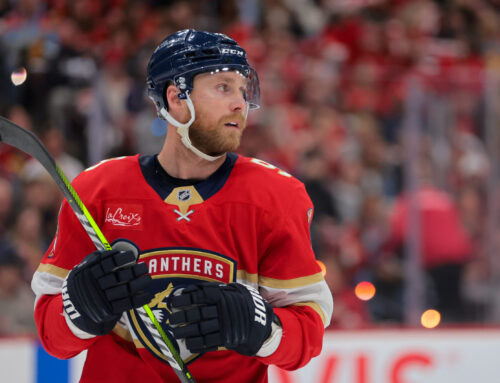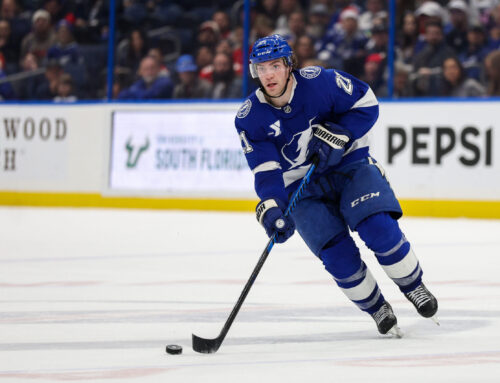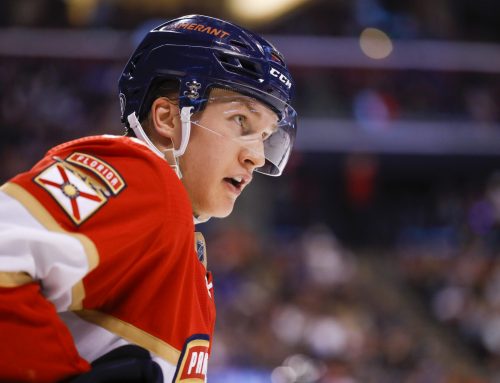
Welcome to another edition of “Forum Buzz,” a column where I dissect popular recent posts from the DobberHockey Forums. Pretty much anything within the forums might be covered, other than trades (those usually will get their own separate write-ups on the site and are also covered in the next day’s Ramblings) and signings (those tend to be dissected in Alex MacLean’s weekly Capped column). With that out of the way, let’s get rolling!
Topic #1 – Who’ll be the new “Crosby vs. Ovechkin” in terms of the best in fantasy debate?
Although poll results that tallied your votes from just a couple of weeks ago suggest Crosby and Ovechkin are far from done in terms of being productive, if we’re going to compare players in order to debate who’s the best of the best in fantasy, it would no longer be those two. But then which two should it be, and why?
The person who started the thread threw several names out there; but I’m with those who say it’s once again a center and a winger for the current debate – Connor McDavid and Nikita Kucherov. Although Kucherov doesn’t have the SOG and Hits that made Ovi such a fantasy stud, he brings more to the table in terms of pure points than Ovi did. As for McDavid, he’s lived up to his hype, with back-to-back 40+ goal, 100+ point seasons for a non-playoff team.
So who’s better – McDavid or Kucherov? I’m going with McDavid, and it’s because I think we’ve yet to see his top gear, whereas I think we’re already witnessing peak Kucherov based on his age (three years older than McDavid) and his strong supporting cast. That latter point is especially key, since once the team around McDavid gets better he could explode. Think of it this way – this season Edmonton scored a total of 229 goals, with McDavid nabbing a point on 116 of them, for a rate of 50.6%. And although Kucherov just posted the highest single season point total of any NHLer since the 1990s (!), his 128 points this season still represents a considerably smaller fraction (40.1%) of the 319 goals scored by the Lightning than what McDavid did for the lowly Oilers.
So in my opinion, what it boils down to is although Kucherov might indeed be the true best there is in fantasy at this very moment, if you had to start a team from scratch today and were building in order to win your league in three to five years, McDavid might be the wiser pick of the two because by then he should be in his prime for a likely better Oilers team whereas Kucherov could be starting to show signs of slowing down and/or the Lighting might be less of a powerhouse.
Could any other NHLer give either one a run for their money? Probably not, as although the Leafs and Jets are stacked and will score goals galore, their points will be spread around enough to not allow for any one player to be elite enough for comparison to either of these two. And as for Jack Eichel, whose name was also tossed out – no offense to him, but he’s not in the same conversation as these two.
Topic #2 – How “for real” is Erik Gustafsson?
After a lackluster start to his NHL career (which saw him play 41 games for Chicago in 2015-16, spend all 2016-17 in the AHL then parts of last season with Chicago – where he was often a healthy scratch – and in the AHL) not only did Gustafsson manage to stick with the Hawks for good this season, he became one of the most productive defensemen in the entire NHL with 60 points in79 games. What makes that total all the more impressive is it came after he started the season with just seven points in his first 21 contests, meaning he produced at a 75-point full season pace for several months!
Is Gustafsson a player who had this in him all along and just needed an opportunity? If so, then how “for real” is he, and what should we expect in future seasons? Let’s see what the numbers tell us.
Looking back at his NHL experience prior to 2018-19 for clues, Gustafsson’s IPP, points per 60 minutes, and PP stats don’t jump off the page; however, the team’s shooting percentage with him on the ice at 5×5 was 8.79 in 2015-16 and 9.22 in 2017-18. Those are very good numbers for a defenseman, and suggest that even before he himself was producing the team was able to score more by having him out there. What’s more – he was able to do just as well (9.09%) for 2018-19.
It is notable that Gustafsson’s offensive zone starting percentage was 59.7% for 2018-19, even though he was playing 22:35 per game. Yet who’s to say that can’t continue? After all, the Hawks have plenty of d-men who can eat up tougher minutes, allowing Gustafsson to be deployed much like Torey Krug or Tyson Barrie, namely with the main purpose of helping to create offense.
All these things having been considered, it’s also worthwhile to look at past comparables to see if other d-men who have produced monster numbers in a season ended up never doing as well again. As it turns out, there are over 100 instances of a defenseman hitting 55 points in a season since 2000-01. Of these, 17 were by players who did so only once during the time period, with two (Ray Bourque, Al MacInnis) being by all-time greats closing out their careers and five (Dennis Wideman, Brian Campbell, Mathieu Schneider, Sheldon Souray, Kimmo Timonen) coming via players age 30+ who lucked into one great season. Although Gustafsson is a late bloomer, there’s a difference between someone doing this for the first time at age 30+ versus, like Gustafsson, at age 27 in what’s his first full season.
That leaves ten other “one-timers.” Of them, five were younger than Gustafsson (Oliver Ekman-Larsson, Torey, Krug, Shayne Gostisbehere, Seth Jones, and Morgan Rielly) when they posted 55+, so they could easily hit the mark again, and three (Dustin Byfuglien, Ryan Whitney, Kevin Shattenkirk) were hampered by injuries yet nevertheless scored at a 55+ point pace in at least one additional season. That leaves just two who posted 55+ points in a season but never did so again – Shea Weber and Dion Phaneuf. And say what you will about Gustafsson, but he’ll never be confused with either of those two. Overall, this data is reassuring and suggests Gustafsson has a good shot of hitting the 55+ point mark again.
It might just be that Gustafsson is the second coming of Brian Rafalski, who made his NHL debut at age 26 and had a 52-point breakout at age 27, then topped the 55-point mark or scored at a 55-point pace four more times. If you’re a Gustafsson owner, I’d hold onto him because more likely than not what we’re seeing from him will be his norm – or close to it – as opposed to a one season fluke output.
Topic #3 – What’s the outlook on Nolan Patrick?
One key with Patrick is he didn’t play in the NHL during his age 18 season, so he’s 20 now, which is a big difference from being 19 as a second-year player. If we look at other forwards who, since 2000-01 and for their first two seasons, played in 125+ games at age 19 and 20, we see a total of 40 others. Of those, 33 had a better point per game average through those first two seasons than Patrick; and of the six who didn’t, five never amounted to anything and the sixth (Tom Wilson) had poor stats early on due to how he was being deployed. It’s not all unfavorable news though, as Patrick’s SOG per game through his first two seasons ranks him 25th of the 40; and among those below him in that area were fantasy notables such as Jakub Voracek, Bo Horvat, David Perrron, Josh Bailey, Ales Hemsky, and, yet again, Wilson. In all, discouraging comparables in terms of points, but not so bad if we look at SOG.
Let’s examine beneath the surface numbers, starting with IPP. As noted in previous columns, even if a young player isn’t scoring in droves and/or is not playing with the most talented forwards on his team, his IPP should still be high if he possesses a nose for scoring that could ultimately lead him to be a success a bit further down the road.
Patrick’s IPP was 68.2% last season and for 2018-19 is just a tad lower at 66.0%. While it would have boded better for him to see one or both of these numbers at or above the key 70% threshold that I’ve noted as the demarcation point between players who can be merely good versus those who can be great, it’s still a quality IPP. As for scoring in general, Patrick looks to have essentially produced at the same rate as last season; however, he did so with an offensive zone starting percent for 2018-19 of 46.4%, which was a good bit less than last season’s 53% plus he apparently was dealing with a nagging injury for a while. Accordingly, his scoring holding steady can be viewed almost as a step up.
As far as the power play, for the second season in a row Patrick took the ice for about a third of Philly’s man advantage time, landing again 1:35-1:50 per game in PP ice time. From this Patrick tallied eight PPPts last season but only two for 2018-19. With similar deployment and roughly comparable line mates on the PP in both seasons, it’s clear that Patrick was snake bit on the PP this year, so that likely cost him close to a handful of points.
So overall, Patrick’s numbers for 2018-19 were brought down by a lower OZ% and unsustainably bad luck on the PP. Given that he’ll be a year older and with another season of experience under his belt, Patrick should be able to enter 40-45+ point territory for 2019-20. And notwithstanding some discouraging player comparables, I think he has a chance to be a solid player, although perhaps not ultimately living up to his second overall draft selection. Looking into my crystal ball, I’d say there’s a 75% chance he hits 65+ points at least once in his career, but only a 20% chance of him ever becoming a point per game player, yet also only a 10% chance he never posts at least 50 points in any season.
Topic #4 – What’s the future hold for Samuel Girard?
Girard has much in common with Patrick, as he too is playing is his second NHL season as a 20-year-old and saw his scoring stay roughly in neutral from his rookie to sophomore seasons. So as with Patrick, let’s start by looking at player comparables.
Unlike with forwards, there have been far fewer rearguards who played regularly as 19 and 20 year-olds since 2000-01. In fact, only nine other defensemen since 2000-01 also played 150+ games for their first and second seasons at age 19 and 20. And although Girard’s points per game ranks him 8th among the ten, that put him ahead of Victor Hedman and within 0.05 points per game behind the likes of Morgan Reilly and Seth Jones. Girard also ranks 8th in SOG per game, once again ahead of Hedman and fairly close to Seth Jones, but this time also closer to the likes of Noah Hanifin and Tyler Myers, whereas the more successful d-men like Drew Doughty, Morgan Reilly, and Zach Werenski were in a higher echelon. So overall, Girard’s comprables are more encouraging than Patrick’s, yet still don’t inspire assuredness that Girard is poised to be a fantasy force, let alone a star.
In terms of his metrics, Girard took a step back this season, as his offensive zone starting percentage rose from 53.5% to 57.1% yet his IPP dropped from 37.7% to 32.1% and his point per 60 minutes dipped from 1.1 per game to 1.0. No wonder he failed to be able to improve his production.
What also can’t be ignored is Girard is clearly a distant second in terms of offensive defenseman on the Avs, with Tyson Barrie getting essentially double the PP Time and an even higher OZ% at 62%. As long as Barrie is in the fold, Girard figures to have a tough time getting deployed in a manner that would result in him producing much more than he already is. And although Barrie is a UFA after next season and may opt to go elsewhere or be priced out of staying in Colorado, keep in mind that the Avs have another 20 year-old defenseman in their system in Cale Makar, who projects to be a potential superstar and might ultimately be the one who steps into the role that Barrie occupies if Barrie departs, leaving Girard still on the outside looking in when it comes to fantasy-favorable deployment.
Given all this, the future does not look promising for Girard, who figures to have barriers to becoming the go to offensive defenseman for Colorado both now and in the coming years. The best hope might be for Makar to make enough of an immediate impact that the Avs feel they can deal Girard, who could thrive on another team that’s more in need of blueliner offense. Either that or Makar becomes a more well-rounded defensemen who is called upon by the Avs to play in all situations, allowing Girard to bask in offensively favorable minutes. But given what we’ve seen from Makar that seems less likely, leaving the future looking not to bright for Girard if he remains an Av.
********
Questions needed for Mailbag column
As a reminder, I’m always seeking questions for my monthly mailbag column, where I answer your fantasy hockey questions. Please continue to send me your questions either by private messaging them to me (rizzeedizzee) via the DobberHockey Forums or by sending an email to admin@dobbersports.com with “Roos Mailbag” as the subject line.





 MTL
MTL
 PIT
PIT FLA
FLA S.J
S.J MIN
MIN CGY
CGY L.A
L.A TOR
TOR
